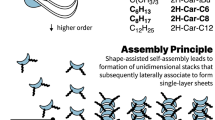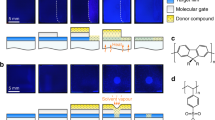Abstract
Self-sorting on surfaces is one of the big challenges that must be addressed in preparing the organic materials of the future. Here, we introduce a theoretical framework for templated self-sorting on surfaces, and validate it experimentally. In our approach, the transcription of two-dimensional information encoded in a monolayer on the surface into three-dimensional supramolecular architectures is quantified by the intrinsic templation efficiency, a thickness-independent value describing the fidelity of transcription per layer. The theoretical prediction that exceedingly high intrinsic efficiencies will be needed to experimentally observe templated self-sorting is then confirmed experimentally. Intrinsic templation efficiencies of up to 97%, achieved with a newly introduced templated synthesis strategy, result in maximal 47% effective templation efficiency at a thickness of 70 layers. The functional relevance of surface-templated self-sorting and meaningful dependences of templation efficiencies on structural modifications are demonstrated.
This is a preview of subscription content, access via your institution
Access options
Subscribe to this journal
Receive 12 print issues and online access
$259.00 per year
only $21.58 per issue
Buy this article
- Purchase on Springer Link
- Instant access to full article PDF
Prices may be subject to local taxes which are calculated during checkout



Similar content being viewed by others
References
Diederich, F. & Stang, P. J. (eds) Templated Organic Synthesis (VCH-Wiley, 1999).
Li, X. & Liu, D. R. DNA-templated organic synthesis: nature's strategy for controlling chemical reactivity applied to synthetic molecules. Angew. Chem. Int. Ed. 43, 4848–4870 (2004).
Jacobsen, M. F., Ravnsbæk, J. B. & Gothelf, K. V. Small molecule induced control in duplex and triplex DNA-directed chemical reactions. Org. Biomol. Chem. 8, 50–52 (2010).
Röthlingshöfer, M., Gorska, K. & Winssinger, N. Nucleic acid-templated energy transfer leading to a photorelease reaction and its application to a system displaying a nonlinear response. J. Am. Chem. Soc. 133, 18110–18113 (2011).
Lund, K. et al. Molecular robots guided by prescriptive landscapes. Nature 465, 206–210 (2010).
O'Sullivan, M. C. et al. Vernier templating and synthesis of a 12-porphyrin nano-ring. Nature 469, 72–75 (2011).
Chichak, K. S. et al. Molecular Borromean rings. Science 304, 1308–1312 (2004).
Cougnon, F. B. L., Au-Yeung, H. Y., Pantos, G. D. & Sanders, J. K. M. Exploring the formation pathways of donor–acceptor catenanes in aqueous dynamic combinatorial libraries. J. Am. Chem. Soc. 133, 3198–3207 (2011).
von Delius, M., Geertsema, E. M. & Leigh, D. A. A synthetic small molecule that walks down a track. Nature Chem. 2, 96–101 (2010).
Carnall, J. M. A. et al. Mechanosensitive self-replication driven by self-organization. Science 327, 1502–1506 (2010).
Prins, L. J. & Scrimin, P. Covalent capture: merging covalent and noncovalent synthesis. Angew. Chem. Int. Ed. 48, 2288–2306 (2009).
Yoder, N. C. & Kumar, K. Selective protein–protein interactions driven by a phenylalanine interface. J. Am. Chem. Soc. 128, 188–191 (2006).
Zhang, J., Jing, B., Janout, V. & Regen, S. L. Detecting cross talk between two halves of a phospholipid bilayer. Langmuir 23, 8709–8712 (2007).
Sakai, N. et al. Self-organizing surface-initiated polymerization: facile access to complex functional systems. J. Am. Chem. Soc. 133, 15224–15227 (2011).
Lista, M., Areephong, J., Sakai, N. & Matile, S. Lateral self-sorting on surfaces: a practical approach to double-channel photosystems. J. Am. Chem. Soc. 133, 15228–15230 (2011).
Sakai, N. & Matile, S. Stack exchange strategies for the synthesis of covalent double-channel photosystems by self-organizing surface-initiated polymerization. J. Am. Chem. Soc. 133, 18542–18545 (2011).
Sakai, N., Mareda, J., Vauthey, E. & Matile, S. Core-substituted naphthalenediimides. Chem. Commun. 46, 4225–4237 (2010).
Misek, J. et al. A chiral and colorful redox switch: enhanced π acidity in action. Angew. Chem. Int. Ed. 49, 7680–7683 (2010).
Chong, Y. S., Dial, B. E., Burns, W. G. & Shimizu, K. D. Covalent locking and unlocking of an atropisomeric molecular switch. Chem. Commun. 48, 1296–1298 (2012).
Alvey, P. M., Reczek, J. J., Lynch, V. & Iverson, B. L. A systematic study of thermochromic aromatic donor–acceptor materials. J. Org. Chem. 75, 7682–7690 (2010).
Safont-Sempere, M. M., Fernández G. & Würthner F. Self-sorting phenomena in complex supramolecular systems. Chem. Rev. 111, 5784–5814 (2011).
Wu, A. X. & Isaacs, L. Self-sorting: the exception or the rule? J. Am. Chem. Soc. 125, 4831–4835 (2003).
Jiang, W. & Schalley, C. A. Integrative self-sorting is a programming language for high level self-assembly. Proc. Natl Acad. Sci. USA 106, 10425–10429 (2009).
Taylor, P. N. & Anderson, H. L. Cooperative self-assembly of double-strand conjugated porphyrin ladders. J. Am. Chem. Soc. 121, 11538–11545 (1999).
Ajami, D., Hou, J. L., Dale, T. J., Barrett, E. & Rebek, J. Disproportionation and self-sorting in molecular encapsulation. Proc. Natl Acad. Sci. USA 106, 10430–10434 (2009).
Botterhuis, N. E., Karthikeyan, S., Spiering, A. J. H. & Sijbesma, R. P. Self-sorting of guests and hard blocks in bisurea-based thermoplastic elastomers. Macromolecules 43, 745–751 (2010).
Shaller, A. D., Wang, W., Gan, H. & Li, A. D. Q. Tunable molecular assembly codes direct reaction pathways. Angew. Chem. Int. Ed. 47, 7705–7709 (2009).
Bain, C. D. & Whitesides, G. M. Formation of monolayers by the coadsorption of thiols on gold: variation in the length of the alkyl chain. J. Am. Chem. Soc. 111, 7164–7175 (1989).
Charbonnaz, P., Sakai, N. & Matile, S. Self-organizing surface-initiated polymerization of perylenediimides on indium tin oxides. Chem. Sci. 3, 1492–1496 (2012).
Acknowledgements
The authors thank D. Jeannerat, A. Pinto and S. Grass for NMR measurements, the Sciences Mass Spectrometry (SMS) platform for mass spectrometry services, and the University of Geneva, the European Research Council (ERC Advanced Investigator), the National Centre of Competence in Research (NCCR) Chemical Biology and the Swiss NSF for financial support. E.O. acknowledges a Sciex Fellowship.
Author information
Authors and Affiliations
Contributions
E.O., M.L. and N.T.L. synthesized compounds. E.O. and M.L. carried out the templation studies on the surfaces. N.S. and S.M. directed the study, and contributed to the design, execution and interpretation of the experiments and writing of the manuscript.
Corresponding author
Ethics declarations
Competing interests
The authors declare no competing financial interests.
Supplementary information
Supplementary information
Supplementary information (PDF 2312 kb)
Rights and permissions
About this article
Cite this article
Orentas, E., Lista, M., Lin, NT. et al. A quantitative model for the transcription of 2D patterns into functional 3D architectures. Nature Chem 4, 746–750 (2012). https://doi.org/10.1038/nchem.1429
Received:
Accepted:
Published:
Issue Date:
DOI: https://doi.org/10.1038/nchem.1429



